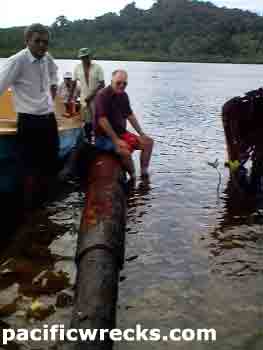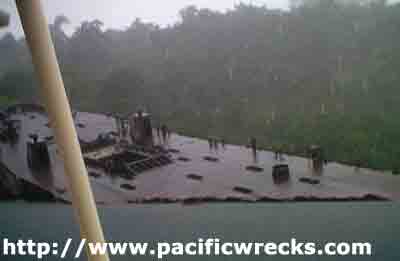I have just returned from Guadalcanal after a visit
accompanied by two remarkable veterans of that campaign. These were
two Marines revisiting that unique time in their lives. I traveled there
with Frank Teague a Marine who was on board the USS Portland, and Bishop
Paul Moore who was a Marine in G/2/5 in 1942.
Frank Teague was a Marine, in 1942 was stationed
on the heavy cruiser, USS Portland. My other guest was Bishop Paul
Moore, a Lieutenant in G company 2nd Battalion 5th Marines in 1942.
Anyone who participated in that campaign would have stories to tell
that forever would be etched in their memories. Frank and Paul were
no exception to that rule.
Frank Teague
Knowing Frank had been on the Portland, I mentioned
to him how lucky the ship must have been. I had read that on the
26th October at the Battle of Santa Cruz, three torpedoes had hit
the Portland and all three failed to explode!
When I mentioned this Frank looked at his wife,
Karin, and said "John I will tell you a story about that incident."
"About a week before that Battle I had
a dream. It was such a vivid dream that I told my shipmates about
it. In my dream I saw the ship being hit by three torpedoes (that
didn't explode) and then I had an image of the ship being covered
by trees. I certainly had the attention of my shipmates after the
torpedoes hit us. However none off us had any thoughts about what
the trees could mean, after all we were a heavy cruiser!
The USS Portland was the seventh ship in line.
Capt Dubose graduated from Annapolis in 1913, so 13 was his lucky
number. The battle of Savo started on the morning of Nov 13, 1942.
Thirteen wasn't necessarily a lucky number for us this time because
we were hit by a torpedo that did explode. The order was given to
abandon ship but was canceled.
At daylight although crippled we saw the Japanese
destroyer Yudachi also crippled. Our Captain sank the Yudachi after
signaling to her of our intentions and for them to abandon ship.
We then limped into Tulagi Harbor where we were tied up alongside
Palm trees and covered with camouflage netting and trees! We spent
a month there before going to Sydney for more effective repairs.
John I have never had a premonition or a dream like that before
or since."
During our week-long stay in Guadalcanal we took
a boat across Iron Bottom Sound crossing the battle spots of that
naval engagement and visited the spot were the Portland had been
tied up. Frank said that the visit was a 'completion' for him.
Paul Moore
Was for twenty years the Episcopalian Bishop
of New York. On August 7, 1942 2nd Lt. Paul Moore, Jr. G/2/5 landed
on Blue Beach on Tulagi. On that site where he came ashore, much to
Bishop Moore's surprise and delight, now stands the Anglican (Episcopalian)
Cathedral for the Central Province.
On Guadalcanal we visited many of the famous Battlefields.
Of particular interest to The Bishop was the sand spit at the mouth
of the Matanikau River. On the 27th September 1942 Lt Moore tried
unsuccessfully to cross the sand spit Attacking Japanese positions
on the Western bank he was unable to make the crossing losing several
men in the attempt. A further attempt slightly upstream was made
to ford the river, when he noticed that one of his men had had his
jaw shot away after reaching the Japanese side.
Lt Moore and his sergeant rescued that man who
lives today. After checking his Marines who had been killed on the
sand spit the attempted crossing was called off. Lt Moore was awarded
the Silver Star for that action.
On the 1st November, the 1st and 2nd Company 5th
Marines along with the Whaling Group, were involved in action where
they did cross the Matanikau. The objective being to sweep around
the Japanese positions west of the Matanikau and cut them off west
of Point Cruz.
On the morning of 3rd November Lt Moore's G Company
coming down from Hill 84 had almost reached the beach line. Kneeling
up to throw a grenade at a Japanese machine gun position. Moore
was shot through the chest. Doctors still marvel at how the bullet
missed his heart. "It must have been on the downbeat when went
through you" they say. Lapsing into unconsciousness that was
the last action Moore saw on Guadalcanal. For performances during
this sweep he was awarded the Navy Cross.
We visited the location where he almost lost his
life. Whilst there I reflected that in 1942 General Vandergrift
had pulled back to the other side of the Matanikau only a week later.
In a surprised voice he kept saying to me "are you sure?"
He never knew that he nearly gave up his life for ground that was
given back.
He spent a month in Hospital having nightmares
about a Japanese 37mm gun at the end of his bed. I enclose a photo
taken of the Bishop and a Japanese 37mm taken during our trip.







